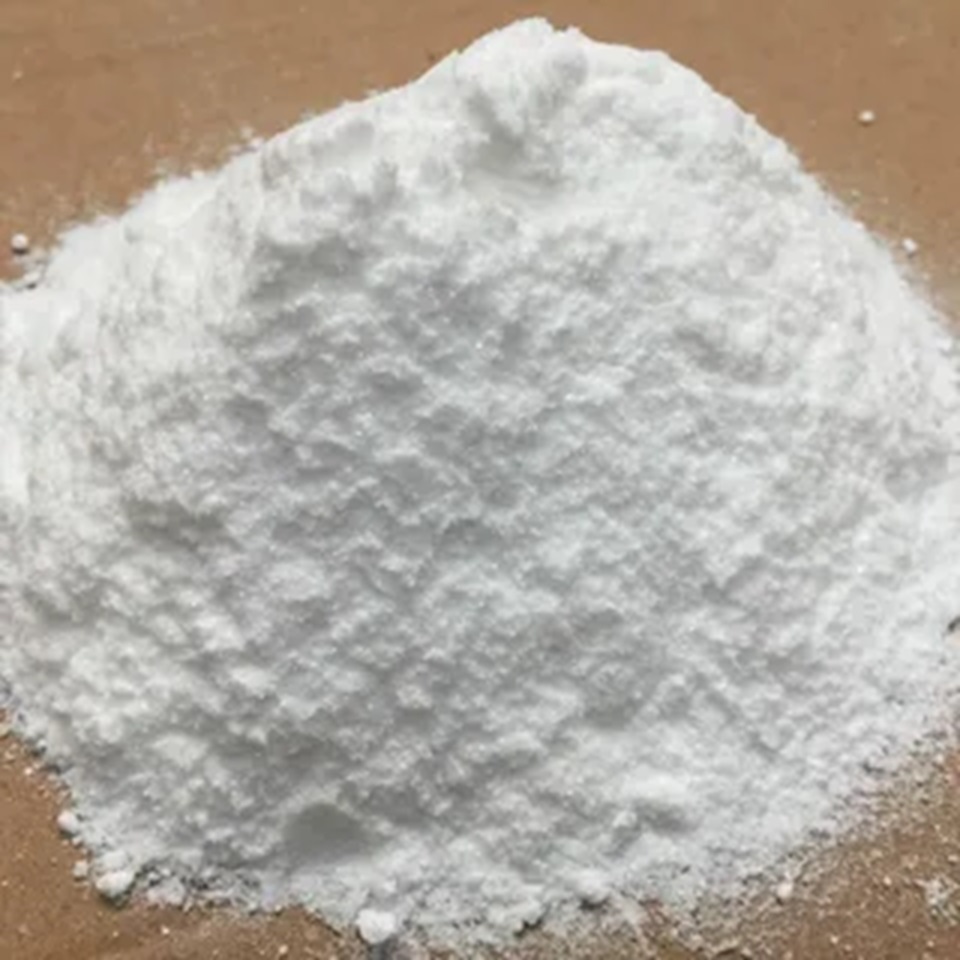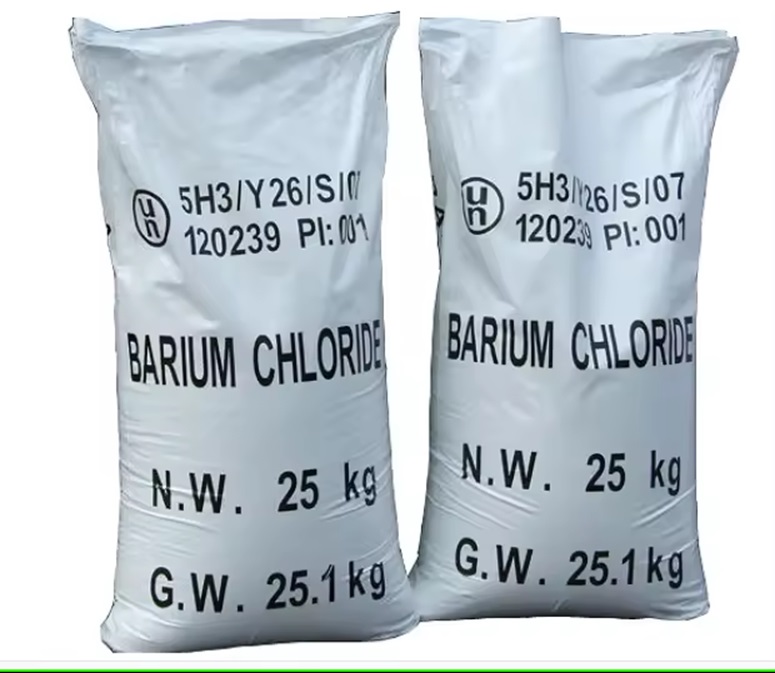We unleash your business potential by maximize the business innovation.
Send EmailBarium chloride, 10361-37-2
CAS: 10361-37-2
Molecular Formula: BaCl2
Names and Identifiers
| Name | Barium chloride |
| Synonyms | Barium chloride Barium Chloride Anhydrous Barium chloride,anhydrous |
| CAS | 10361-37-2 |
| EINECS | 233-788-1 |
| InChI | InChI=1/Ba.2ClH/h;2*1H/q+2;;/p-2 |
Physico-chemical Properties
| Molecular Formula | BaCl2 |
| Molar Mass | 208.24 |
| Density | 3.856 |
| Melting Point | 960℃ |
| Boling Point | 1560℃ |
| Water Solubility | Soluble in water and methanol. Insoluble in acids, ethanol, acetone and ethyl acetate. Slightly soluble in nitric acid and hydrochloric acid. |
| Physical and Chemical Properties | Colorless monoclinic crystals. (Type α) |
| Use | Mainly used for metal heat treatment, barium salt manufacturing, electronic instrument, and used as water softener |
Risk and Safety
| Hazard Symbols | T - Toxic |
| Risk Codes | R20 - Harmful by inhalation R25 - Toxic if swallowed |
| Safety Description | S45 - In case of accident or if you feel unwell, seek medical advice immediately (show the label whenever possible.) |
| UN IDs | UN 1564 |
Upstream Downstream Industry
Introduction
barium chloride is one of the most important soluble barium salts, also known as "barium salinization", chemical formula BaCl2, there are colorless monoclinic and colorless cubic crystals, monoclinic crystals are transformed into cubic crystals at 962 ℃. At room temperature, it is a white and shiny monoclinic crystal, odorless, bitter and salty taste. Soluble in water, insoluble in acetone, ethanol and ether, slightly soluble in acetic acid and sulfuric acid. Barium chloride crystallized from aqueous solution often contains 2 crystal water. When heated to 113 ℃, the crystal water is lost and becomes anhydrous barium chloride and white powder. It can be used to identify and separate SO2-4 ions, purify salt brine, mainly used to make barium salts and pigments, and can also be used as hard water softener, mordant in wool weaving and leather industry, insecticide to control plant pests, etc. Industrial production of barium chloride is mainly made of barite containing high barium sulfate as raw material, mixed with pulverized coal and calcium chloride, and its reaction formula is as follows: BaSO4 + 4C + CaCl2 & rarr; BaCl2 + CaS + 4CO & uarr;.
barium chloride is incombustible. It's highly toxic. React violently in contact with boron trifluoride. Ingestion or inhalation can cause poisoning. It mainly invades the human body through the respiratory and digestive tract, and there will be salivation, burning pain in the mouth and esophagus, stomach pain, colic, nausea, vomiting, diarrhea, elevated blood pressure, firm and irregular pulse, Spasm, a lot of cold sweats, weak muscle strength, gait, vision and speech disorders, dyspnea, dizziness, tinnitus, and usually conscious. In severe cases, sudden death can occur. Barium ions have an exciting effect on muscles and gradually turn into paralysis. Rat oral LD50150mg/kg, mouse abdominal LD5054mg/kg, rat intravenous LD5020mg/ kg, dog oral LD5090mg/kg.
rinse with water for skin contact and wash thoroughly with soap. Rinse with plenty of water for eye contact. Make the patients who inhale dust out of the contaminated area, move to the fresh air, place rest and keep warm, if necessary, perform artificial respiration and seek medical treatment. If you take it by mistake, rinse your mouth immediately, lavage your stomach with warm water or 5% sodium sulfate solution, and catharsis. Even if it is taken by mistake for more than 6 hours, gastric lavage is necessary. 500ml ~ 1,000 ml of 1% sodium sulfate can be used for slow intravenous drip, and 10ml ~ 20ml of 10% sodium thiosulfate can also be used for intravenous injection. Potassium supplement and symptomatic treatment should be carried out.
The soluble barium salt barium chloride absorbs rapidly, so the symptoms of poisoning develop rapidly, and can die at any time due to cardiac arrest or respiratory muscle paralysis. Therefore, the first aid must be seconds.
Dissolved grams per 100 ml of water at different temperatures (℃):
31.2g/0℃;33.5g/10℃;35.8g/20℃;38.1g/30℃;40.8g/40℃
46.2g/60℃;52.5g/80℃;55.8g/90℃;59.4g/100℃
Security information
| production method | anhydrous barium chloride is prepared by heating barium chloride dihydrate to dehydrate above 150 ℃. Its BaCl2·2H2O[△]→BaCl2 2H2O |
| category | toxic substances |
| toxicity classification | highly toxic |
| acute toxicity | oral-rat LD50: 118 mg/kg; Oral-mouse LD50: 150 mg/kg |
| flammability hazard characteristics | Non-combustible; toxic chlorides and barium-containing smoke are produced on the fire site |
| storage and transportation characteristics | The warehouse is ventilated and dry at low temperature; stored separately from food additives |
| fire extinguishing agent | water, carbon dioxide, dry powder, sand |
| occupational standards | TLV-TWA 0.5 mg (barium)/m3; STEL 1.5 mg (barium)/m3 |
Security information
| dangerous goods mark | T,Xi,Xn |
| hazard category code | 22-25-20-36/37/38-36/38-36 |
| safety instructions | 45-36-26-36/37/39 |
| dangerous goods transport number | UN 3264 8/PG 3 |
| WGK Germany | 1 |
| RTECS number | CQ8750000 |
| TSCA | Yes |
| customs code | 2827 39 85 |
| HazardClass | 6.1 |
| PackingGroup | III |
| Toxicity | LD50 orally in Rabbit: 118 mg/kg |
MSDS
| SigmaAldrich | English |
| ALFA | Chinese |
| ALFA | English |
Nature
| melting point | 963°C (lit.) |
| boiling point | 1560°C |
| density | 3.856 g/mL at 25°C (lit.) |
| storage conditions | 2-8°C |
| solubility | H2O: soluble |
| morphology | beads |
| color | White |
| Specific gravity | 3.9 |
| PH value | 5-8 (50g/l, H2O, 20℃) |
| water solubility | Soluble in water and methanol. Insoluble in acids, ethanol, acetone and ethyl acetate. Slightly soluble in nitric acid and hydrochloric acid. |
| sensitivity | Hygroscopic |
| Merck | 14,971 |
| stability | Stable. |
Use
| use | Mainly used in metal heat treatment, barium salt manufacturing, electronic meters, and as a water softener |
| use | It is used as a dehydrating agent and analytical reagent, and also used for heat treatment in mechanical processing. For others, see Barium Chloride Dihydrate. |
| use | Calibration instruments and devices; evaluation methods; working standards; quality assurance/quality control; others. |

